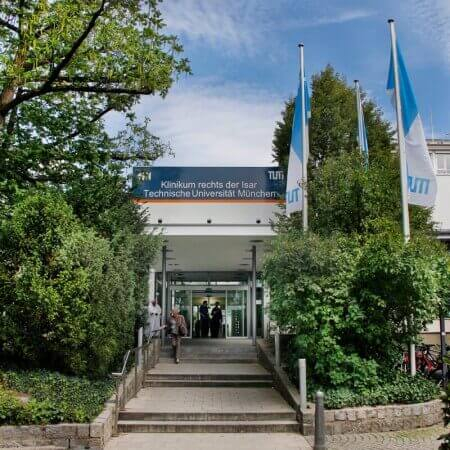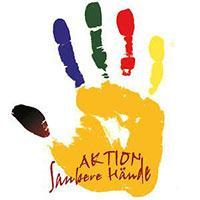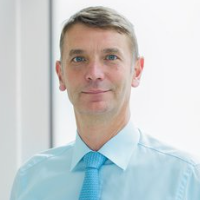Liver Cancer — Embolization or Chemoembolization: treatment in the Best Hospitals in the World
Treatment prices are regulated by national law of the corresponding countries, but can also include additional hospital coefficients. In order to receive the individual cost calculation, please send us the request and medical records.

Department of Interventional Radiology
The Department of Interventional Radiology offers the full range of imaging examinations, as well as innovative image-guided minimally invasive techniques for the treatment of tumors, vascular diseases and internal pathologies (for example, CT, MRI, PET-CT, SPECT). The department's doctors have deep knowledge and colossal experience in the field of interventional radiological methods of treatment, which represent an excellent alternative to open surgical interventions. Despite the high level of technical equipment and the presence of advanced computerized systems, the focus is always on the person with his individual needs. Compliance with current clinical protocols and high professionalism of the department's specialists contribute to the successful clinical practice, as well as the reputability of the department among the best medical facilities of this kind in Germany.




Department of Interventional Radiology and Neuroradiology
The Department of Interventional Radiology and Neuroradiology offers a full range of advanced imaging diagnostics and minimally invasive treatments on both an inpatient and outpatient basis. The department has state-of-the-art medical equipment for imaging tests such as X-ray, computed tomography, magnetic resonance imaging, digital subtraction angiography, and mammography. The medical facility also performs many highly effective interventional therapeutic procedures under image guidance, which in many cases allow patients to avoid traumatic open surgery. For example, the department successfully performs local fibrinolysis, thrombectomy, percutaneous transluminal angioplasty, hemostasis, transarterial chemoembolization, uterine artery embolization, and other procedures. The department's neuroradiologists specialize in brain and spinal cord imaging and the treatment of central nervous system disorders. Interventional neuroradiology focuses on the treatment of carotid artery stenosis, brain aneurysms, arteriovenous malformations, dural fistulas, subdural hematomas, brain tumors, skull base and spinal tumors, and chronic back pain. The department's medical team has extensive clinical experience in their areas of expertise. The specialists are guided by the recommendations of the German Society for Interventional Radiology and Minimally Invasive Therapy (DeGIR) and the German Society for Neuroradiology (DGNR), which helps to achieve the best results.






Department of Adult and Pediatric Diagnostic, Interventional Radiology, Neuroradiology
The Department of Adult and Pediatric Diagnostic, Interventional Radiology, Neuroradiology is one of the best institutions of its kind in Germany and offers patients the full range of radiological studies and imaging-guided minimally invasive therapy. The department’s scope of tasks also includes imaging diagnostics in children of all age groups, detection and invasive treatment of cerebral vascular pathology (neuroradiology). Patient care is provided both on an inpatient and outpatient basis.






Liver cancer is not the most common malignant tumor, but it is very aggressive. This type of cancer has an unfavorable prognosis, therefore, in terms of mortality from cancer causes, liver cancer ranks fourth in the world. Few patients are candidates for surgical treatment. If it is not possible, then hepatic artery chemoembolization becomes the main method of fighting the tumor.
Content
- What are embolization and chemoembolization
- How long has chemoembolization been used
- How is the treatment provided
- After the procedure
- Benefits of chemoembolization
- Repeated chemoembolization
- Why is it worth undergoing embolization abroad
- Treatment in Europe with Booking Health at an affordable price
What are embolization and chemoembolization
Embolization is the closure of the lumen of an artery.
The tumor grows very quickly. It needs a lot of blood to grow in size and metastasize. Therefore, the neoplasm becomes overgrown with arteries, consuming a large amount of nutrients and oxygen.
The essence of the therapeutic method is to impair the blood supply to the tumor. To do this, emboli are injected into the lumen of the blood vessels. These are substances that clog the lumen of the arteries. The tumor does not receive blood and dies off quickly.
Embolization has been used since the middle of the twentieth century. But today this procedure is carried out in a different way. Embolization can very rarely be used in isolation. Basically, doctors use chemoembolization, which is a combination of embolization and regional chemotherapy.
The essence of this method is that high concentrations of chemotherapy drugs are injected into the vessels feeding the tumor. Such quantities cannot be used systemically (intravenously) due to significant harm to the patient's health. However, topical application is safer. Doctors can multiply the dosage without increasing systemic toxicity.
In modern medicine, chemoembolization with microspheres is most often used. The microspheres are saturated with chemotherapy drugs. They are released several days or even several weeks after embolization, thereby damaging cancer cells.
Another option is oil chemoembolization. Unlike microspheres, the vessels do not close forever, but for a while. This makes it possible to carry out the procedure multiple times.
How long has chemoembolization been used
Hepatic artery chemoembolization has been used in medicine since the 1970s. Regensberg was one of the first to describe it. He published the results of 250 patients. For vascular embolization, the specialist used a suspension of Karyolysin, a hemostatic sponge and Thrombovar.
Japanese scientists headed by R. Yamada are considered to be the official authors of the method. In 1979, experts used a gelatin sponge saturated with chemotherapy drugs. It was injected under X-ray control into the hepatic artery in patients with unresectable liver cancer.
In 1982, lipiodol, a drug for oil chemoembolization, was used for the first time. This drug has two unique properties: it accumulates the chemotherapy drug and remains inside the tumor for a long time.
In the 21st century, drug-saturated microspheres appeared. They absorb the drug and release it through the ion exchange mechanism. As a result, the doctors were able to ensure not a short-term, but a long-term effect of chemotherapy on liver carcinoma cells. With the help of microspheres, it is possible to achieve a more pronounced effect. In addition, the method is less toxic than oil chemoembolization.
How is the treatment provided
A catheter is used to deliver emboli and chemotherapy drugs. It is injected through the vessels in the leg or arm.
The treatment is minimally invasive. It is performed under X-ray guidance. The doctor makes an incision and delivers the catheter to the hepatic artery. He then injects a contrast agent and uses an x-ray to check where the liver cancer is getting its blood supply. After that, the doctor injects emboli into the lumen of these vessels. He uses microspheres of different diameters to block the arteries feeding the tumor.
Transarterial chemoembolization has been used in medicine for decades. It is especially often used in countries with a developed healthcare system. The technique combines good efficiency and safety indicators.
Although the doctor clogs the blood vessels of the liver, minimal damage is caused to the parenchyma. This is due to the peculiarities of the blood supply to the tumor. It receives 90% of its blood from the hepatic artery system. At the same time, 80% of the blood supply to a healthy liver comes from the portal vein system. Although the blood flow in it decreases as a result of the procedure, the damage to the tumor is much greater than to the healthy parenchyma. In most patients, liver function is not significantly reduced.
In countries with developed healthcare systems, superselective chemoembolization is performed. This means that doctors block the smallest possible arteries located directly near the tumor. With this approach, the procedure becomes even safer.
After the procedure
Postembolization syndrome develops after the procedure. It is associated with the death of tissues that are disconnected from the blood supply. This syndrome is usually not dangerous. Its manifestations can be eliminated by drugs. Symptoms disappear within 2-3 days.
Postembolization syndrome may have the following manifestations:
- Right upper quadrant pain.
- Nausea.
- Vomiting.
- Temporary worsening of liver failure.
The risk of complications is low – about 10%, and in the best European hospitals this indicator is about 4%. There are three groups of complications: those associated with the blockage of non-target vessels, with the action of chemotherapy drugs or a contrast agent, as well as complications in the area of the vessel puncture. Most complications are not severe.
Benefits of chemoembolization
The best results in the treatment of liver cancer can be achieved with the surgical method. Only complete removal of the tumor can help cure the disease. But in 80% of cases, at the time of diagnosis, the patient is not considered a candidate for surgical treatment: due to the advanced stage of cancer or reduced liver function. In such situations, embolization of the tumor becomes the main treatment method. Doctors clog the arteries that feed the neoplasm, causing the carcinoma to shrink in size.
In 2018, the European Society for Medical Oncology (ESMO) issued new guidelines for hepatic artery chemoembolization. This method is now recommended as a standard method even in the earliest stages of liver cancer (BCLC 0 and (BCLC A). Previously, it was used only in the intermediate stage (BCLC B).
The main purpose of embolization and chemoembolization is local control of the tumor. In fact, this treatment is palliative, not radical. Nonetheless, it provides the best possible patient survival rates. After the procedure, life expectancy increases by several years. Chemoembolization can be performed repeatedly.
The advantages of the method:
- A dual mechanism of action: doctors use chemoembolization to simultaneously block off the arteries feeding the tumor and deliver large doses of chemotherapy drugs to the liver.
- Embolization is safe for health when compared to surgery.
- No significant trauma: manipulations are performed through the vessels, but not through a large incision in the abdomen.
- There is no need for a long hospital stay.
- Since the treatment procedure is minimally invasive, long-term rehabilitation is not required after it.
- Good tolerance of the procedure: after it, postembolization syndrome develops, but its manifestations gradually regress and completely disappear after 2-3 days.
- The best survival rates of any treatment except surgery.
- Possibility of multiple use of embolization.
- The procedure can be successfully used even with large neoplasms, when it is impossible to perform ablation of tumor foci.
- Compatibility of embolization with any other treatment for liver cancer.
Chemoembolization performed for the first time is almost always effective. The complete response rate (disappearance of tumor foci) is about 70%. In another 30% of cases, a partial response is achieved: the neoplasm in the liver can be reduced by at least 30%.
Repeated chemoembolization
Some patients undergo several chemoembolization procedures throughout their lives.
The first procedure is usually the most successful. Tumor foci can decrease several times. The disease does not progress long enough: several months or even several years. But at a certain point, the growth of the tumor may resume. In this case, doctors perform repeated chemoembolization.
There are no restrictions on the number of hepatic artery embolizations performed. It can be performed as long as the patient responds to therapy and as long as there is no major damage to health.
If chemoembolization no longer works, doctors resort to systemic therapy. The criterion for making such a decision is considered to be 2 unsuccessful embolization procedures, after which medical specialist reveal:
- Tumor growth.
- Increase in the number of tumor foci.
- Increase in tumor markers of the neoplasm after the procedure.
- Development of vascular invasion.
- Development of extrahepatic metastases.
The best results from repeated chemoembolization procedures can be achieved in the patients with isolated intrahepatic progression of the disease, with preserved liver function.
Why is it worth undergoing embolization abroad
Many patients choose to travel to countries with advanced healthcare systems to undergo cancer treatment. In many states with a poor level of medicine, chemoembolization is not carried out at all or is not performed effectively enough, according to outdated methods.
You can undergo treatment in Europe. There are several reasons why it is worth going to one of the countries with a high level of healthcare system:
- The use of modern methods of chemoembolization with saturated microspheres.
- Performance of superselective embolization – emboli are injected into the minimum caliber arteries located as close to the tumor as possible to minimize the risk of side effects.
- If possible, the catheter is inserted through the radial rather than the femoral artery in order to reduce the risk of complications in the puncture site and to relieve the patient of the need to comply with strict bed rest on the first day after the procedure.
- The possibility of embolization even with atypical location of the blood vessels feeding the liver.
- High-precision diagnostics allow perfect treatment planning.
- Chemoembolization procedures abroad can be successfully combined with other methods: ablation, radiation therapy, systemic drug treatment.
Treatment in Europe with Booking Health at an affordable price
To undergo treatment in one of the European hospitals, please use the services of the Booking Health company. On our website, you can find out the cost of treatment in different hospitals, compare prices and book a medical care program in one of the countries with developed healthcare systems. Transarterial embolization in European hospitals will be easier and faster for you, while the cost of treatment will be lower.
Please leave your request on our website. Our employee will contact you and advise you about the treatment in Europe. Booking Health will take care of the organization of your trip. We will provide the following benefits for you:
- We will choose a hospital for treatment in Europe, whose doctors specialize in the treatment of liver cancer and achieve the best results.
- We will help you overcome the language barrier, establish communication with your attending physician.
- We will reduce the waiting time for the start of the medical care program and book a doctor's appointment on the most suitable dates.
- We will reduce the price. The cost of treatment in German hospitals will be lower due to the lack of additional coefficients for foreign patients.
- We will take care of all organizational issues: documents for entering the country, transfer from the airport, hotel, interpreter, etc.
- We will prepare a program and translate medical documents. You do not have to repeat the previously performed diagnostic procedures.
- We will provide communication with the hospital after treatment in Europe.
- We will organize additional diagnostic examinations and treatment in European hospitals, if necessary.
- We will buy medicines abroad and forward them to your native country.
- We will help you keep in touch with the hospital and the doctor after treatment in Europe.
You will receive treatment from the best doctors in the world. The Booking Health staff will help reduce the cost of treatment and take care of all organizational issues, and you will only have to focus on restoring your health.
Authors:
The article was edited by medical experts, board certified doctors Dr. Nadezhda Ivanisova and Dr. Vadim Zhiliuk. For the treatment of the conditions referred to in the article, you must consult a doctor; the information in the article is not intended for self-medication!
Our editorial policy, which details our commitment to accuracy and transparency, is available here. Click this link to review our policies.
Sources:

